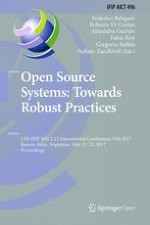1 Introduction
2 The Open Source Officer Role Description
-
Governance and support systems - The Open Source Officer is a part of Open Source Operations and in charge for governance and support, including processes etc.
-
Education - the officer identifies the education needs in an organization as well as ensures that needed education is provided to the organization.
-
Developer Engagement - The OSO leads and mentors the software organizations in the engagement in OSS projects (maturing and taking on their responsibilities). The organizations take the formal responsibility for the OSS engagement activities.
-
Business Models - although having no direct responsibility, the OSO should engage in business strategy development discussions to influence, support, and advice business entities to enable a full advantage of using OSS in generating and sustain business.
-
Leadership and Culture - The OSO can support and advice in the creation of organization and leadership culture that is suitable for ensuring extensive benefits from OSS. The actual task of creating an organization is the top management responsibility.
-
Strong leadership skills are required as a central part of the role is to develop and manage governance and support systems as well as the education program required to advance in the open source maturity.
-
Communication skills - strong written and verbal English skills are required as the role involves communication with local and global organizations – including company external organizations, e.g. purchasing a training course from an external company.
-
Functional and technical skills - good change management skills are required as the role supports the changes in the mindset of individuals, support required transformation of organizational structures as well as influence the culture of the organization. Good understanding of OSO that is reaching beyond the basic copyright issues or OSS compliance, business and market logic implications as well. Good understanding on the fundamentals of software engineering.
-
Technology knowledge - the OSO need to be a very good generalist and understand the technological aspects of software as well as other aspects. This is particularly important for OSOs not originating from software organizations.
-
Engage actively in the Open Source Board operations - the Open Source Board is the governing function for Open Source within the company or a business unit. The two main tasks for the board involve: (1) Maintaining the corporate policies set by the executive management regarding OSS operations and ensuring that the documentation is up to date, and (2) Vetting and approving contribution proposals and ensuring that both business needs and IPR are taken into consideration.
-
Ensure that Open Source related processes and trainings are provided - that includes ensuring that the processes are defined, documented and implemented in relevant organizations and that the training is provided.
-
Act as an interpreter between engineers and lawyers - ensure that OSS related questions gets timely answered and that engineers and developers are proactive and positive about using OSS components without unnecessary license related fears.
-
Act as the company’s external interface in Open Source related questions - especially for the questions related acquisitions and compliance of the released products.
-
Act as an internal management consultant - that reacts to any request for help or support about the OSS operations or knowledge.
-
Authorities - the OSO has a deciding voice as one of the members of the Open Source Board and can propose changes to OSS related directives and processes.
